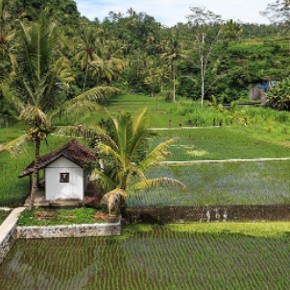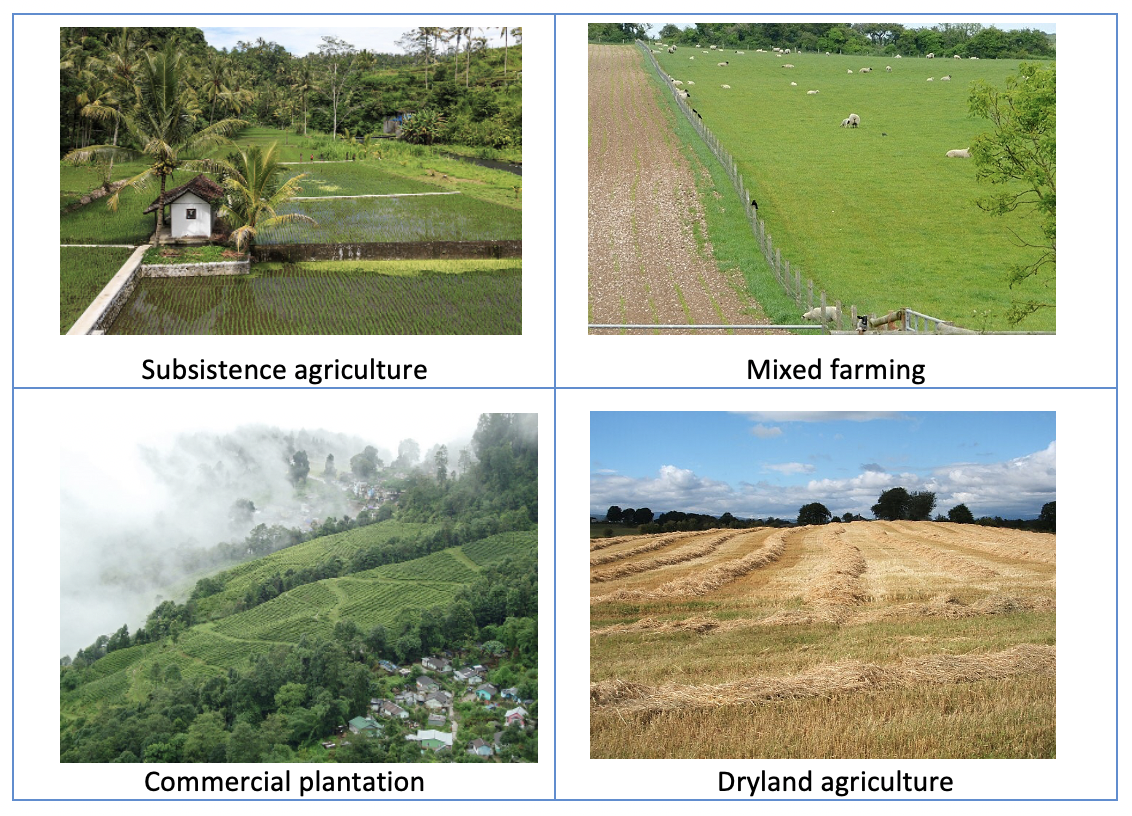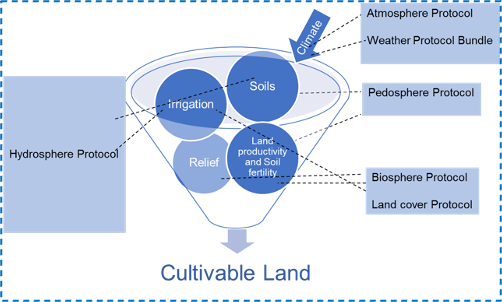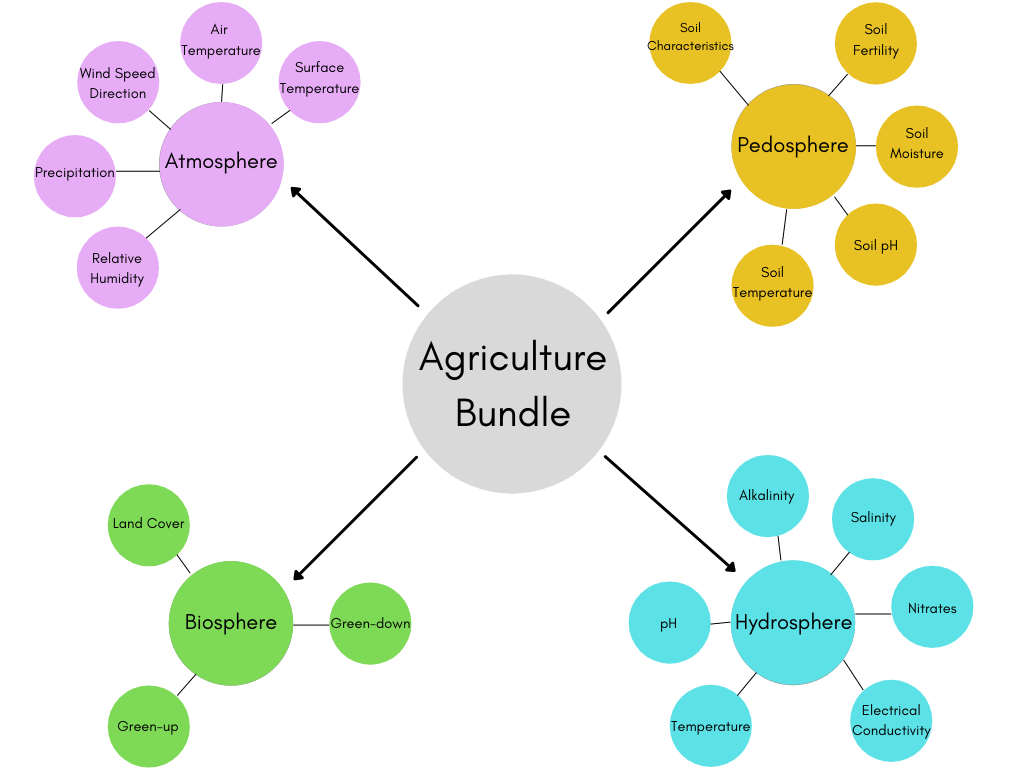Agriculture Bundle - Earth as a System
Agriculture Protocol Bundle
Agriculture is an important source of livelihood in most parts of the world. Before the industrial revolution, it was the primary economic driving force for almost every country worldwide. Even today, around 70% of the world's population relies directly on agriculture as a means of livelihood.
Agriculture also changes as you move across the globe. How land is used agriculturally is based on climate conditions, the type of crop being grown, the scale of cultivation, farming intensity, mechanization level, combinations of livestock, and much more. Check out the pictures below for a brief example of the different ways agriculture can manifest throughout the world.

Agricultural Advances Over the Years
As Green Revolution technologies have advanced over the years, countries have been able to drastically increase their agricultural productivity with increasingly less human labor. Between 1960 and 2015, worldwide agricultural production more than tripled due to these technologies and a significant expansion in the use of land, water, and other natural resources for agricultural purposes.
However, many institutions now recognize that these prodigious benefits were often accompanied by negative consequences like land degradation, salinization of irrigated areas, over-extraction of groundwater, the build-up of pest resistance, and the decline of biodiversity. Furthermore, anthropogenic climate change is also greatly impacting agricultural yields. As the most important factor influencing the suitability of a crop to a particular region, climate accounts for more than 50% of crop variation.
Inside the Agriculture Bundle, you can find a collection of protocols, prompts, and projects related to these issues and their intersections with various Earth Spheres.

Table 1: Various manifestations of agriculture around the globe
Bundle Overview
- Atmosphere: Climate & Weather
- Air Temperature
-
All plants have maximum, optimum, and minimum temperature limits, or cardinal temperature points. Low temperatures affect crop characteristics like survival, cell division, photosynthesis, water transport, growth, and yield, while high temperatures adversely affect mineral nutrition, shoot growth, and pollen development.
-
- Relative Humidity
-
Relative humidity partially determines an area's weather and climate. This ratio of actual water content to saturated vapor content also directly influences plant-water interactions and indirectly affects leaf growth, photosynthesis, pollination, disease proliferation, and economic yield.
-
- Precipitation
-
All plants need water to survive, so precipitation levels are crucial for agricultural development. Usually, regular rain patterns are vital for healthy crops, however, too much or too little rainfall can be harmful to yields. For example, droughts can kill plants and increase erosion, while overly wet weather may cause harmful fungus growth. Understanding rainfall also helps farmers determine appropriate cropping systems, sowing/harvesting schedules, and proper irrigation projects.
-
- Wind Speed Direction
-
The wind's speed and direction can benefit plants by increasing atmospheric turbulence. This turbulence enlarges the supply of carbon dioxide to the plants, resulting in increased cuticular transpiration and greater photosynthesis rates. However, wind can also damage shoots, shed flowers and fruits, uproot shallow plants, inflict chilling injuries, and damage lodging poles for crops like paddy, sugarcane, and banana.
-
- Surface Temperature
-
Surface temperature is a determining factor for the temperature of the soil underneath. Extreme low and high temperatures influence the soil's microbial population and rate of organic matter decomposition. Soil surface temperatures are affected by slope, tillage, soil moisture, soil texture, and organic matter among other factors.
-
- Air Temperature
- Biosphere: Relief & Land Productivity
- Land Cover
- Land cover plays an important role for crop cultivation by creating ideal micro-climates in and around cultivated lands. For example, techniques like alley cropping help prevent soil erosion as well as help with pest control.
- Green-up
-
Plant green-up is initiated when plants are broken out of their dormant states by environmental conditions like sunlight duration, temperature, and rainfall. Agricultural scientists study green-up data to determine how environmental conditions like air and soil temperature, precipitation, soil moisture, and day length affect crop growth.
-
- Green-down
-
Plant green-down, or senescence, marks the end of the growing season for many plants. Like green-up, green-down is initiated by sunlight duration, temperature, humidity, and rainfall.
-
- Land Cover
- Hydrosphere: Irrigation & Land Productivity
- Temperature
- Temperature influences the amount and diversity of aquatic life in a region. However, this biological activity can be disturbed by anthropogenic sources. For example, hot water discharges into lakes and rivers from industrial farming equipment can negatively disrupt aquatic life.
- pH
- pH is an indicator of the acidity or basicity of a solution and is an important factor for determining the suitability of agricultural irrigation water. Irrigation water with a pH outside the normal range (6.5 - 8.4) may cause nutritional imbalances or enhance toxic ion availability to crops.
- Electrical Conductivity
- Electrical conductivity is used to estimate the level of dissolved salts in water. Salts include naturally-occurring minerals and nutrients in soil and water, as well as anthropogenically added salts such as those found in fertilizers. Electrical conductivity is also a measure of water's salinity, too much of which can affect plant growth. Some plants are more susceptible to electrical conductivity levels than others and each species has an electrical conductivity threshold, beyond which yields become negatively impacted.
- Alkalinity
- Alkalinity is a measure of the water's ability to neutralize acid. An alkalinity test measures the level of bicarbonates, carbonates, and hydroxides in the water and results are generally expressed as "ppm of calcium carbonate (CaCO3)." The desirable range for irrigation water is 0 - 100ppm calcium carbonate while levels between 30 - 60ppm are considered optimum for most plants.
- Salinity
- Salinity is the measurement of the amount of dissolved solids, or salts, in water. Water contains many types of dissolved solids, but the most common is sodium chloride (NaCl). Salts in irrigation water are mainly NaCl, chlorides, sulphates, and calcium and magnesium bicarbonates. Using overly saline water for crop irrigation can result in yield loss and decreased quality, however, plants vary greatly in their overall saline tolerance.
- Nitrates
-
In agriculture, nitrogen levels influence and stimulate crop growth. The most readily available forms of nitrogen are nitrate (NO3-) and ammonium (NH₄⁺), but NO3- occurs most frequently in irrigation water. Many fertilizers typically contain nitrogen to increase plant productivity, however, excessive nitrogen can adversely affect crops due to growth over-stimulation, delayed maturity, or degraded crop quality.
-
- Temperature
- Pedosphere: Soils, Land Productivity & Soil Fertility
- Soil Characteristics
- Soil composition dictates the availability of nutrients stored underground as well as how water is stored in and moves through the soil. Scientists use soil composition to determine what types of vegetation are best suited for a specific area.
- Soil Temperature
- Temperature influences the germination of seeds as well as regulates the chemical and biological processes taking place within the soil. Farmers measure their soil's temperature to determine when to plant their crops.
- Soil pH
-
Soil pH controls the chemical forms of different nutrients found within the soil, making them more or less available for plant use. The productivity of a crop is directly linked to the soil's pH value.
-
- Soil Moisture
- Underground moisture dissolves salts and minerals within soil, making it easier for growing plants to absorb these vital nutrients. The level of moisture also influences how much water a plant can absorb.
- Soil Fertility
- Fertile soils contain all the necessary nutrients and structure to support plant growth. By measuring various aspects of their soil, farmers and scientists can work to increase their soil's fertility and crop yield.
- Soil Characteristics
Check out the chart below for a visual representation of how the different protocols and Earth Spheres interact:

Intensive agriculture both instigates negative effects on the land as well as places significant strain on the environment and Earth's other natural resources. Due to these pressures, sustainable agricultural practices have been developed to protect the environment, expand the earth’s natural resource base, and maintain and improve soil fertility.
By practicing sustainable agriculture, we're protecting and managing these vital resources both locally and around the world. According to the United States Department of Agriculture (USDA), the goals of sustainable agriculture include:
- Increasing profitable farm income
- Promoting environmental stewardship
- Enhancing quality of life for farm families and communities
- Increasing production for human food and fiber needs
Managing Agriculture: An Integrated Approach
Maintaining our natural resource base is essential for the sustainable production of food and other agricultural products. Through sustainable agriculture, we can prolong and preserve its benefits to humanity, including food security, nutrition, and personal livelihoods. To appropriately manage our agricultural resources, we must measure the environmental inputs necessary to sustain cultivation in terms of both their quantity and quality.
This will also help us identify the factors that influence our agriculture practices and give us the insight on when to adjust them accordingly. Therefore, these measurements are critical in supporting our efforts to achieve long-term sustainability in our farms and fields.
Citizen Science in Agriculture
Agriculture is one of humanity's oldest multidisciplinary subjects. As such, studying exclusively one scientific discipline alone, like the pedosphere or the atmosphere, doesn't accurately capture a complete understanding of the various inputs necessary to maintain a farm's productivity and ecological impact. This is where the measurements and observations from citizen scientists play an important role.
To achieve a more holistic understanding of the variables that affect crop or livestock, GLOBE has created the agriculture protocol bundle to provide students with the necessary background to learn about the different Earth-sphere interactions that occur within the agricultural sectors of their local communities. Through this big-picture approach, this protocol bundle aims to build a framework for students studying agriculture as a convergence of Earth-system spheres.
Before taking measurements out in your local community, it's beneficial to first focus your approach by creating research questions. A few examples of these questions include:
- Is the soil color the same or different in and around the agriculture fields in your community or district?
- What is the soil type in agriculture fields around your community?
- What is the soil depth horizon in your backyard/school campus?
- What is the relation between the soil's characteristics and crop choice by the farmers?
- How does the soil's moisture vary during different seasons in your local area?
- How do weather parameters like temperature, humidity, and rainfall affect the plant growth in agriculture fields or your home garden?
- How does surface temperature affect watering requirements in your terraced farm or garden?
- How are green-up and green-down cycles manifesting in your neighboring agriculture fields?
- What are the impacts of fertilizer or pesticides on soil characteristics such as pH, electrical conductivity, salinity etc.?
- What are the impacts of organic fertilizers on soil characteristics?
- What does the land cover in a typical agriculture field in your area look like? Is it single or multi-crop cultivation?
Soil Quality and Climate Affect Sweetness of Mangosteen in Nakhon Si Thammarat Province, Southern Thailand
Students: Kodchamon Bunchutam, Monkolrat Junnul and Nutcha Chuayklay
Mentor: Panini Woranetiwut
GLOBE School: Pa Phayom Phitthayakhom School, 320 M. 9 Ban Phrao Subdistrict, Pa Phayom District, Phatthalung 93210 Thailand
1. Introduction, research questions and hypotheses
Southern Thailand is well-known for its high quality and best-tasting Mangosteen. In fact, there is a large number of mangosteen cultivation in Cha-uat District, Nakhon Si Thammarat Province, Southern Thailand. The taste of the mangosteen cultivated and grown in the said districts were found different. In line with this, the researchers would like to investigate and examine if soil quality and climate in this two locations have significant effects on the sweetness of mangosteen.
Research Questions
1. Does the quality of soil affect the sweetness of mangosteen?
2. Does climate affect the sweetness of mangosteen?
3. How does the size affect the sweetness of mangosteen?
Research Hypotheses
1. Soil Quality affects the sweetness of mangosteen.
2. Weather affects the sweetness of mangosteen.
3. Larger mangosteen fruit is sweeter than small one.
2. Materials and Methods
Study area
(a) Ban Tha Samet Village No. 5, Tha Samet Sub-district, Cha-uat District, Nakhon Si Thammarat 80180, Thailand, (Latitude 75544 W, Longitude 99.59, Elevation 17 M)
(b) Ban Lan Na Village No. 3, Koh Khan Sub-district, Cha-uat District, Nakhon Si Thammarat 80180, Thailand, (Latitude 7.54 ’21 N, Longitude 99.57 / 06E, Elevation 22 M)
Materials
The materials used in this research are listed below:
To analyze the soil and weather parameters using GLOBE protocols
- Soil quality
- Hygrometer
- Thermometer
- Tape measure
- Digital Scales
- Carrier bag (capacity 1 kg)
- Rubber band
- Digging shovel / garden shovel / hoe
- Hammer
- Permanent marker
- Aluminum cup
- Clay incubator
To determine and measure the sweetness
- Sweetness meter
- Basin, bowl, and foam plate
- Dropper
- Beaker
- Cloth filter
- Fruit blender
Methods
Soil sampling
1. Mangosteen trees were selected randomly.Canopy was measured in 8 directions and each direction soil samples were collected at 30 cm depth for soil parameter measurement. Soil temperature and moisture were measured in-situ
2. Relative humidity and Air temperature
Relative humidity and air temperature were measured using hygrometer and thermometer respectively
3. Sweetness measurement
Ten fruits per tree were collected and juice was extracted and sweetness was measured using sweetness instrument
3. Results
The table 1 shows that average soil temperature is higher and soil moisture is lower in Ban Tha Samet. However, the pH value is lower in Ban Lan Na compared to Ban Tha Samet. The mangosteen in Ban Tha Samet has a higher sweetness value.
Table 1. Soil parameters and Sweetness in Ban Tha Samet and Ban Lan Na
The table 2 shows that Ban Tha Samet has an average air temperature of 30.6 degrees with a relative humidity of 73.3% with a sweetness value of 23.8. While Ban Lan Na has an average air temperature of 30.7 degrees and relative humidity of 77.9% with sweetness value of 23.2
Table 2. Weather parameters and Sweetness in Ban Tha Samet and Ban Lan Na
Table 3 shows that mangosteen with higher circumference was found to be sweeter than the smaller one.
Table 3. Mangosteen circumference and sweetness
4. Discussion
Based on the research, the sweetness of mangosteen was much different in Ban Tha Samet and Ban La Na. Clearly, the soil quality and climate can affect the sweetness of mangosteen. The higher the soil temperature, the lower the soil moisture, and the higher the air temperature, the lower the relative humidity, this combination of abiotic parameter produced best-tasting or sweetest mangosteen. Furthermore, the researchers were able to compare the size of mangosteen to determine the sweetness. We found out that the mangosteen in Ban Tha Samet was bigger than Ban Lan Na. Thus, the fruit harvested in Ban Tha Samet were sweeter than Ban Lan Na area. Therefore, there is a relationship between studied soil and weather parameters and the quality of the fruit.
5. Conclusion
1. It is concluded that the soil quality had an effect on the sweetness of the fruit. Thus, the mangosteen from Ban Tha Samet has the sweetest taste.
2. Evidently, the mangosteen cultivated and grown with lower relative humidity and higher air temperature was found the sweetest.
3. As expected, the mangosteen with large size has the sweeter taste than the smaller one.
Agriculture is the backbone of communities and countries around the world. However, it often places significant pressure on the Earth's other natural resources and the surrounding environment. To help counteract these side-effects, sustainable agricultural practices are continually being developed to protect local habitats and expand the earth’s natural resource base.
By taking action now, students and citizen scientists can help secure our agricultural resources for future generations by monitoring the changes in cultivated lands around their communities. The contributions of GLOBE students also give farmers and farming communities crucial insights that help them manage their lands both sustainably and ecologically.
FAO: Food and Agriculture Organization
https://geography-revision.co.uk/gcse/agriculture/types-of-agricultural-activity/






